This blog covers the scope of vehicle master data integration and how it works together with vehicle integration delivered by earlier releases of SAP Digital Vehicle Hub.
Pre-requisites:
◉ S/4HANA 2020 FPS 01 or higher
◉ SAP Digital Vehicle Hub 1.1 or higher
◉ SAP Cloud Platform Integration with JMS queue
Concept and Scope of Integration
The vehicle in SAP S/4HANA Vehicle Management System is replicated as Equipment in SAP Digital Vehicle Hub.
From SAP S/4HANA Vehicle Management System perspective, vehicles are nothing but configurable material having a configurable class of type 300 attached to it. This means that the master data for vehicles in SAP S/4HANA Vehicle Management System refers to the assigned variant class, the characteristics, and the possible values assigned to the characteristics. In addition, the vehicle also has a primary status, secondary status, and optionally, vehicle location too.
This integration provides a simple, easy-to-use solution for existing SAP Vehicle Management System customers to set up the necessary vehicle master data in SAP Digital Vehicle Hub and to start their journey in the cloud.
SAP S/4HANA Vehicle Management System -SAP Digital Vehicle Hub Data Model Mapping
As shown in the above picture, SAP Cloud Platform Integration is the middleware for the integration. With the SAP Cloud Platform Integration flows delivered by SAP Digital Vehicle Hub, vehicle master data integration can be easily configured and monitored as per customer requirements. JMS queues in SAP Cloud Platform Integration additionally help to re-try the erroneous integration flows.
Integration Steps in SAP Cloud Platform Integration
The Master Data Integration Content can be found in SAP API Business Hub under package SAP S/4HANA Integration with SAP Digital Vehicle Hub.
Configure and Deploy the following Integration flows :
◉ Replicate Vehicle Attributes from SAP S/4HANA and Replicate Vehicle Attributes to SAP Digital Vehicle Hub
◉ Replicate Vehicle Templates from SAP S/4HANA and Replicate Vehicle Templates to SAP Digital Vehicle Hub
◉ Replicate Vehicle Source System Status from SAP S/4HANA and Replicate Vehicle Source System Status to SAP Digital Vehicle Hub
◉ Replicate Vehicle Location from SAP S/4HANA and Replicate Vehicle Location to SAP Digital Vehicle Hub
The Integration is done in two steps: First of all, the relevant objects’ information from SAP S/4HANA Vehicle Management System is stored in the SAP Cloud Integration JMS queue. As the second step, data is transferred from JMS queues to SAP Digital Vehicle Hub.
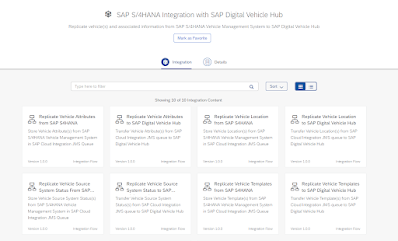
Integration Steps in S/4HANA Vehicle Management System
Define Logical System
Create and configure an RFC destination of Type G using transaction SM59-> Configuration of RFC following the link
Maintain RFC Destinations
Note: As outlined before, each object has different i-flows but the same RFC destination will be re-used. To make this happen, while configuring the RFC destination, the host must be pointing to the SAP Cloud Platform Integration tenant’s home URL: https:<tenant>.cfapps.sap.hana.ondemand.com without any path information. The right endpoint will be derived programmatically for each object.
Maintain SAP Cloud Platform System Details
Use the RFC Destination created in the above step under SPRO-> Logistic Execution-> Vehicle Management System-> Integration with SAP Digital Vehicle Hub-> General Settings-> Maintain SAP Cloud Platform System Details
Maintaining SAP Digital Vehicle Hub Name
It is possible to define a prefix and suffix for the names of Equipment templates, Attributes, Code-lists, Attribute Groups, Locations. This can be done via SPRO-> SAP Reference IMG-> Logistic Execution-> Vehicle Management System-> Integration with SAP Digital Vehicle Hub->General Setting->Define SAP Digital Vehicle Hub Name.
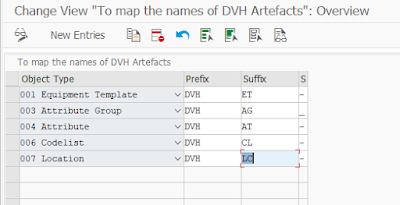
Note: This is an optional activity to define unique names for attributes, attribute groups, equipment templates, etc. in SAP Digital Vehicle Hub and to avoid possible conflicts in names.
Master Data Replication
Replication of the Master data objects shall be done with a report. Launch the report from SAP Area Menu->Logistics>Logistic Execution>Vehicle Management System>Integration with SAP Digital Vehicle Hub>Initial Load of Master Data to SAP Digital Vehicle Hub.
Alternatively, you can use the transaction code VELOMI to launch the report.
As described initially, the Master data objects are :
◉ Characteristics with Characteristic Values
◉ Characteristic Group
◉ Variant Class ( Class Type 300)
◉ Vehicle Status
◉ Vehicle Location
During execution, the report will select the objects and its’ details based on the selection conditions, apply the naming rules (if defined), transform the data as per the target payload format, derive the exact path prefix, and invoke the right i-flow endpoint using Maintain SAP Cloud Platform System Details.
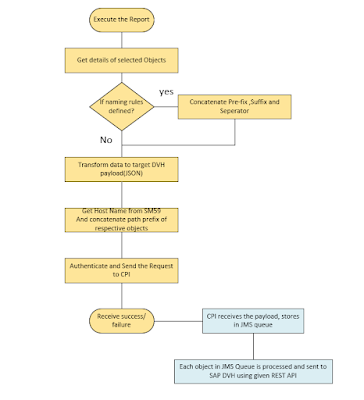
Master Data Replication flow
Variant Class and Characteristics
To understand how the replication of Variant classes and Characteristics takes place, let’s take the following example.
There are 2 characteristics INTERIOR_TRIMS and VCAR_BODY assigned to variant class CL_BMW. Both characteristics are of Data type CHAR and INTERIOR_TRIMS belongs to characteristic group CU_GEN.
The Characteristic VCAR_BODY is defined as below
Here is how variant class CL_BMW looks like.
Note: Characteristics and classes will be replicated only if it is linked to a vehicle model through Classification.
For this, the variant class CL_BMW is assigned to the vehicle model VCAR_VC based on which we are going to create vehicles.
Characteristics Replication
In order to replicate Characteristics to SAP Digital Vehicle Hub,
◉ Choose the radio button Characteristic
◉ Enter necessary selection criteria and Execute.
This will trigger the replication of all the characteristics under the class CL_BMW.
On the SAP Digital Vehicle Hub side, two Code lists are created with characteristic values for each characteristic.
◉ Code list DVH-VCAR_BODY-CL with values BD0C and BD0S
◉ Code list DVH-INTERIOR_TRIMS-CL with characteristic values SATIN SILVER, HIGH-GLOSS BLACK WITH PEARL CHROME, and ALUMINIUM HEXOGAN WITH BLACK-GLOSS
Additionally, it creates two attributes DVH-VCAR_BODY-AT referring to DVH-VCAR_BODY-CL and DVH-INTERIOR_TRIMS-AT referring to DVH-INTERIOR_TRIMS-CL.
Variant Class Replication
Choose the radio button Variant Class, enter necessary selection criteria and Execute.
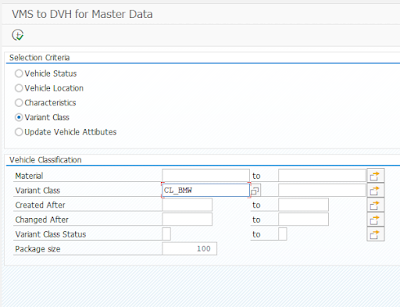
A corresponding Equipment Template and Attribute Group will be created on the SAP Digital Vehicle Hub side after this. All the characteristics under the variant class will be assigned to implicitly created Attribute Groups which will be finally used to form the Equipment Template.
Note: For variant class replication to be successful, all the characteristics of the variant class should be pre-existing in SAP Digital Vehicle Hub as attributes. Otherwise, variant class replication will fail.
Implicit Creation of Attribute Groups
For SAP Digital Vehicle Hub, it is mandatory to have an Attribute group to an Attribute so that it can be assigned to a template. Characteristic group assignment to a characteristic is an optional step on S/4HANA for classification. In such cases, the attribute group name is derived from the class name.
In our example, as VCAR_BODY does not have a group assigned, it follows the name of the variant class to which it is assigned, and thus, the attribute group is created with the name DVH-CL_BMW-AG and the attribute VCAR_BODY will be assigned to it.
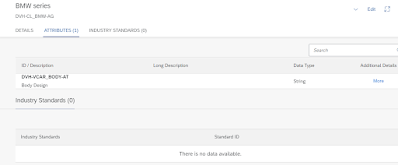
Other characteristic INTERIOR_TRIMS will follow the unique name with the concatenation of class name and characteristic group name and thus, the attribute group will DVH-CL_BMW-CU_GEN-AG and DVH_INTERIOR_TRIMS-AT assigned to it.
Finally, as can be seen below, the Equipment template has the above attribute Groups assigned.
Vehicle Status Replication
To replicate the vehicle status to SAP Digital Vehicle Hub as Source System status, choose the radio button Vehicle Status and enter necessary selection criteria and click on Execute.
Defined vehicle status values are as follows:
On successful execution, a corresponding attribute will be created on SAP Digital Vehicle Hub with a code-list containing all status codes starting with EM*.
This replication will create two attributes on the SAP Digital Vehicle Hub namely, DVH-VLC_MMSTATU-AT, DVH-VLC_SDSTATU-AT for primary and secondary status respectively.
It also creates a Code-list named DVH-VLC_STATU-CL with all values starting from EM* and will assign the created code list to both the primary and secondary attributes.
Vehicle Location Replication
Similarly, choose Vehicle Location and Execute to replicate the SAP S/4HANA Vehicle Locations as Locations in SAP Digital Vehicle Hub.
This will read all locations from the system, adjust the names as per prefix, suffix, and separator and create Locations on SAP Digital Vehicle Hub.
For example, if there is a location named TRANSIT with details shown below:
As per the naming convention, a location DVH-TRANSIT-LC along with the address details will be created on DVH as shown below.
With this, we are almost done with the necessary Master data replication to SAP Digital Vehicle Hub in a few clicks! We are just 2 steps away to complete the configuration to start our vehicle replication.
As the next step, execute the same master data report with Update Vehicle Attributes
This will pre-fill the Vehicle Attribute Mapping node under IMG ->Logistics Execution->Vehicle Management System->Integration to SAP Digital Vehicle Hub ->Vehicle Transfer->Maintain Vehicle Attribute Mapping with SAP DVH Attributes.
Finally,
navigate to IMG ->Logistics Execution->Vehicle Management System->Integration to SAP Digital Vehicle Hub ->Vehicle Transfer->Maintain Vehicle Attribute Mapping with SAP DVH Attributes and manually assign the vehicle Model VCAR_VC to the Equipment Template DVH-CL_BMW-ET.
Choose the vehicle model and navigate to child node Custom Mapping of Vehicle Attributes and SAP Digital Vehicle Hub Attributes to see the pre-populated entries.

That was it! the system is all set for vehicle transfer now.
Tips for Troubleshooting
After successful replication, you will get a success message. Success message does not guarantee that replication happens properly. This only means that that data is sent to Cloud Platform Integration tenant. Then the user can do troubleshooting to verify the replication.
◉ Make sure that you receive a success message after the master data report execution. This says that vehicles are sent to SAP Cloud Platform Integration successfully.
◉ Login to SAP Digital Vehicle Hub /Asset Intelligent Network to check the replicated objects.
◉ If not found, check the SAP Note 2993289 on certain limitations of the master data replication.
◉ If the data is proper, log in to the Cloud Platform Integration tenant to see if any integration flows went into error or not.













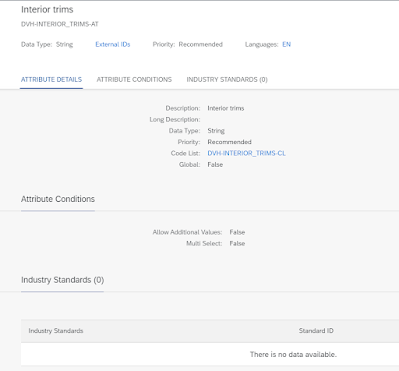







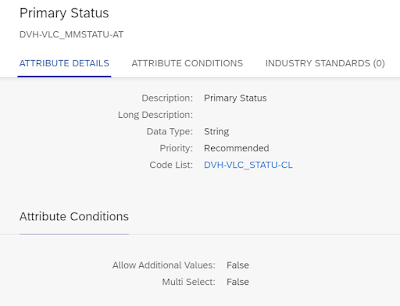
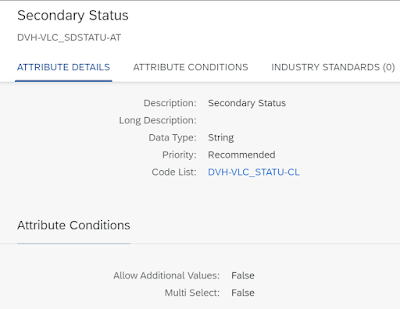







No comments:
Post a Comment